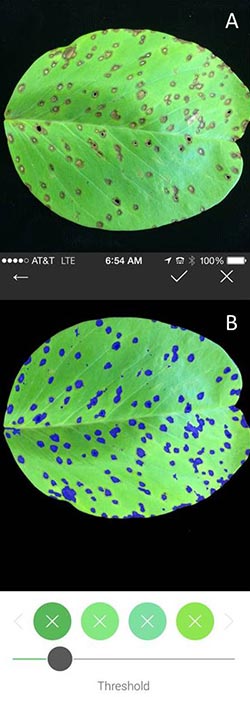Free app helps diagnose leaf-or-death situations
By Krishna Ramanujan

A new app lets users practice eMedicine on plants.
Leaf Doctor analyzes a photograph of a damaged leaf and quantifies the percentage and severity of disease on that leaf, an important measure for researchers and extension agents in the field.
The free app is available for iPhones, iPads and iPods, with an Android version in development. A paper describing the app was published in April in the journal Plant Disease.
Researchers, extension agents and growers seeking to eradicate a disease will have a tool in the palm of their hands: Leaf Doctor provides quick access to information to determine whether a treatment is reliable. For example, a plant pathologist looking at the effects of different fungicides and doses may now simply take a photo of a diseased leaf and accurately calculate the percentage of disease severity based on different treatments.
“It distinguishes all diseases that have a different color than healthy areas” on a leaf or plant surface, said Sarah Pethybridge, Cornell assistant professor of plant pathology, who tested the app with the developer, co-author Scot Nelson, a specialist in plant and environmental protection sciences at the University of Hawaii at Manoa.
Compared with the industry standard, an $800 program called Assess that runs on a laptop or desktop, the Leaf Doctor app is 10 times faster, easier to use and free, said Pethybridge.
To use Leaf Doctor, users take a photo of a leaf or part of a diseased plant, then use software to put a black background behind the image and import the photo into the app. The user then interactively selects up to eight healthy areas on the leaf. The app finds and clearly distinguishes diseased areas in blue and can provide an accurate percentage of the surface area that is diseased and rate disease severity on a scale of one to 10.
“This is a reliable way to get actual percentages of disease severity,” by comparing pixels covered by disease and pixels covered by healthy tissue, Pethybridge said.
The app study was funded by two United States Department of Agriculture Hatch projects, one managed by the College of Tropical Agriculture and Human Resources at the University of Hawaii at Manoa, and the other managed by the New York Agricultural Experiment Station at Cornell University in Geneva.
Media Contact
Get Cornell news delivered right to your inbox.
Subscribe